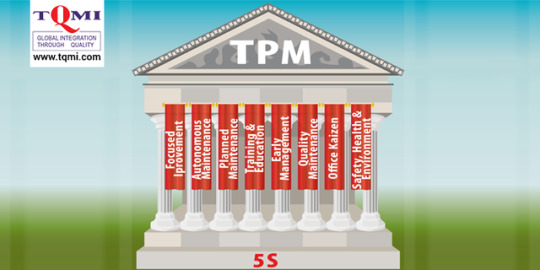#tpmimplementation
Explore tagged Tumblr posts
Text
Implement TPM: Step-by-Step Guide to Boost Efficiency
#tpm#totalproductivemaintenance#tpmimplementation#efficiencyboost#stepbystepguide#maintenanceoptimization#industrybestpractices#continuousimprovement#manufacturingefficiency#zerodowntime#preventivemaintenance#leanmanufacturing#equipmentmaintenance#workplaceproductivity#factorymanagement
1 note
·
View note
Photo

Total Productive Maintenance (TPM)
TQMI provides TPM training in India that aims at Restructuring the corporate culture through improvement of human resources and plant equipment. Visit Website: https://goo.gl/MhMdM9
0 notes
Text

TPM Best Practices: Achieve Peak Efficiency & Zero Downtime
In today’s competitive industrial landscape, keeping machines running efficiently is critical to maintaining productivity and reducing costs. Equipment failures and unexpected breakdowns lead to costly downtime, delayed production, and increased maintenance expenses. This is where Total Productive Maintenance (TPM) comes in a structured approach to improving equipment reliability, reducing downtime, and maximizing operational efficiency.
➥ What is Total Productive Maintenance (TPM)?
Total Productive Maintenance (TPM) is a proactive maintenance strategy designed to keep machinery and equipment in optimal condition by involving every employee in maintenance activities. Unlike traditional maintenance, which is often reactive (fixing equipment after it breaks), TPM focuses on preventing breakdowns, minimizing defects, and increasing overall efficiency.
TPM is built on the principle that equipment operators should take ownership of routine maintenance tasks, such as cleaning, lubrication, and minor repairs, while maintenance teams focus on more complex issues. This helps improve machine longevity and ensures that maintenance issues are addressed before they cause failures.
➲ Key Objectives of TPM
✔️ Reduce unplanned downtime
✔️ Improve equipment reliability
✔️ Enhance production efficiency
✔️ Reduce maintenance costs
✔️ Minimize defects and waste
✔️ Improve workplace safety
➥ The 8 Pillars of TPM
Total Productive Maintenance (TPM) is a structured approach to maintaining equipment and improving efficiency in manufacturing and industrial settings. The goal is simple: reduce downtime, prevent failures, and keep machines running at peak performance. TPM is built around 8 key pillars to achieve this, each focusing on maintenance and productivity. Let’s dive into them one by one in a detailed and easy-to-understand manner.
1. Autonomous Maintenance (Jishu Hozen) – Empowering Operators
In many industries, only the maintenance team handles equipment servicing. This often leads to delays, as minor issues go unnoticed or are not fixed on time. Autonomous maintenance gives machine operators the responsibility of performing basic maintenance tasks such as:
✅ Cleaning equipment regularly
✅ Lubricating moving parts
✅ Checking for minor wear and tear
✅ Detecting unusual sounds, vibrations, or leaks
Read more: https://www.knowledgewale.com/2025/03/tpm-best-practices.html
#tpmbestpractices#totalproductivemaintenance#zerodowntime#peakefficiency#tpmimplementation#tpmstrategy#tpmpillars#preventivemaintenance#predictivemaintenance#equipmentreliability#industrialmaintenance#continuousimprovement#leanmanufacturing#maintenanceoptimization#tpmbenefits#tpmtraining#autonomousmaintenance#proactivemaintenance#maintenanceefficiency#reducingdowntime
0 notes
Text

Implement TPM: Step-by-Step Guide to Boost Efficiency
Total Productive Maintenance (TPM) is a powerful strategy that helps industries reduce downtime, improve equipment efficiency, and create a culture of continuous improvement. However, implementing TPM is not just about fixing machines; it’s about changing how people work, think, and take ownership of equipment maintenance.
If you want to successfully implement TPM in your industry, follow these detailed and practical steps.
➥ Step 1: Get Management Buy-In and Commitment
➲ Why is this important?
TPM requires a major shift in how maintenance and operations are handled. Without strong leadership support, it will be difficult to get employees to follow through.
➲ How to do it?
✅ Educate top management about the benefits of TPM (reduced downtime, cost savings, increased productivity).
✅ Assign a TPM Coordinator who will lead the implementation.
✅ Allocate a budget and resources for training, equipment upgrades, and maintenance improvements.
➥ Step 2: Build a Cross-Functional TPM Team
➲ Why is this important?
TPM is not just for the maintenance team—it involves operators, supervisors, quality control, and management working together.
➲ How to do it?
✅ Create a TPM team with members from different departments.
✅ Define clear roles and responsibilities for each team member.
✅ Set up a regular meeting schedule to discuss TPM progress and challenges.
➥ Step 3: Conduct a TPM Awareness Program for Employees
➲ Why is this important?
Many employees may not understand TPM or may resist change. A proper training program helps them see how TPM benefits them and makes their work easier.
How to do it?
✅ Organize workshops and training to explain TPM concepts.
✅ Use real-world examples to show how TPM has improved other industries.
✅ Encourage employees to share their concerns and ask questions.
➥ Step 4: Identify Critical Machines and Set TPM Goals
Why is this important?
Not all machines are equally important. Some machines are more critical to production, and failures can cause huge losses.
Read More: https://www.knowledgewale.com/2025/03/implement-tpm.html
#tpm#totalproductivemaintenance#tpmimplementation#efficiencyboost#stepbystepguide#maintenanceoptimization#industrybestpractices#continuousimprovement#manufacturingefficiency#zerodowntime#preventivemaintenance#leanmanufacturing#equipmentmaintenance#workplaceproductivity#factorymanagement
0 notes